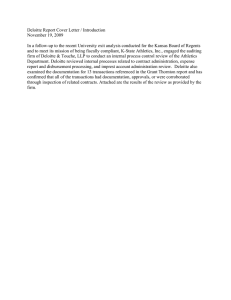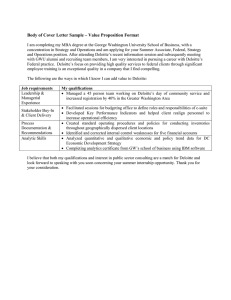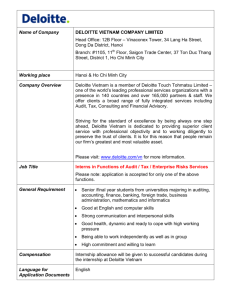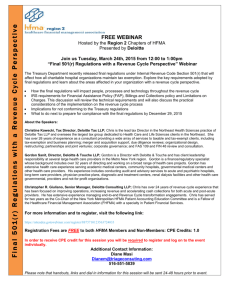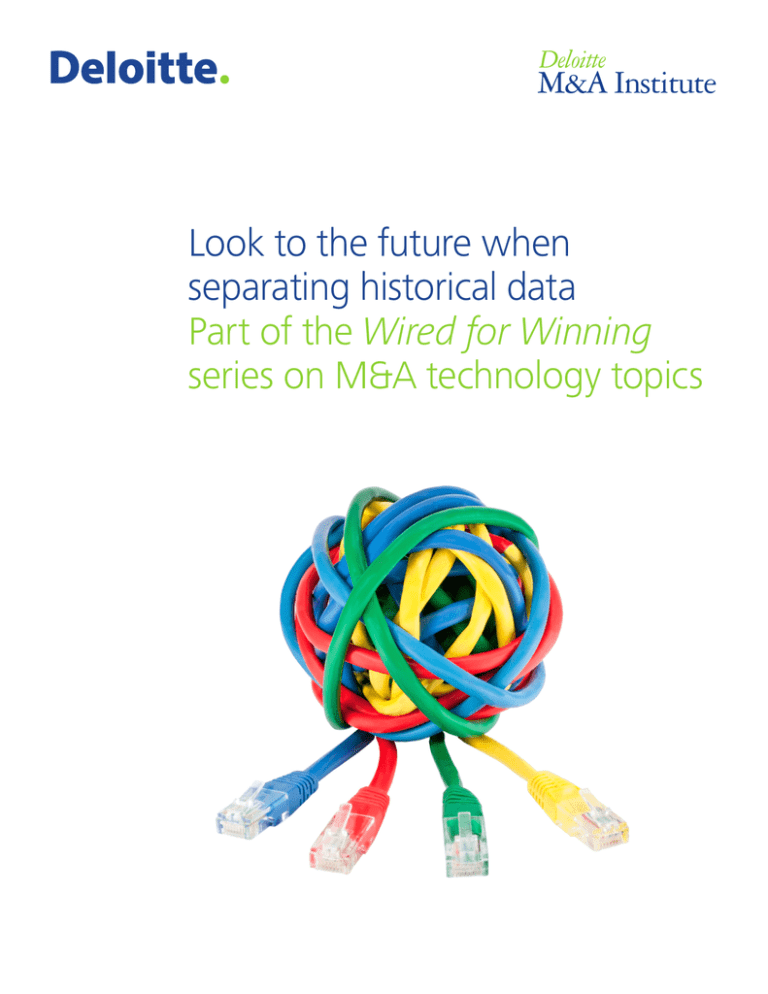
Deloitte
M&A Institute
Look to the future when
separating historical data
Part of the Wired for Winning
series on M&A technology topics
Day 1 readiness, integration/separation planning, and major
systems cutovers command the lion’s share of buyers’ and
sellers’ focus in M&A transactions in the post-announcement
phase of the deal. Historical data, by contrast, is often
relegated to a mere afterthought. Ironically, long after the
deal close, sellers and buyers frequently find themselves
wrangling with major cost, resource, and infrastructure
constraints to solve for final ownership of and access to
historical data—especially in carve-out scenarios. Heading
this problem off at the pass starts by taking a forwardlooking approach to historical data.
There are important business, legal, and regulatory reasons
why both sides in an M&A transaction need access to
historical data pre- and post-deal close. However, some
sellers underestimate the importance of early planning
for data separation and management. As a result, these
companies may find it difficult to quickly and efficiently
locate, access, and contain data required for audit,
litigation, and regulatory matters. In addition, lack of
proactive planning may require significant efforts down the
road to complete historical data separation to support a
Day 1 or Day 2 cutover.
This article explores the factors that may complicate
migrating and managing historical application data,
describes potential solutions and associated considerations,
and offers a high-level approach that may ease the process
for both seller and buyer.
Complicating factors and questions
Historical data, sometimes known as “Books and Records”
can take many forms: pre-close (owned by seller); postclose (owned by buyer); online (currently residing in
applications); offline (archived after a period of time in
systems or data warehouses); structured (application/
database/system data); unstructured (spreadsheets,
presentations; emails and hard copy/paper documentation);
comingled (mixed with data from other business units
(BU)) and non-comingled (belonging solely to one BU).
The abundance, prevalence, and diversity of historical data
speak to its organizational value. However, these same
factors also add to the complexity of separating, retaining,
retrieving, and accounting for historical data during and
after an M&A transaction. Both seller and buyer should
consider the following complicating factors and key
questions as they develop requirements for a historical data
separation solution (see figure 1).
Figure 1: Complicating factors
Complicating factors
Key questions
Business, legal,
and regulatory
environment
• What are the historical data deal requirements (e.g., Purchase Agreement, Transition
Services Agreement, and Master Reorganization Agreement)?
• What are the country-specific regulatory requirements (e.g., EU Data Protection
Directive, Bank Holding Company, Sarbanes-Oxley, Works Councils)?
• What are the legal implications of sharing data (e.g., anti-trust)?
• What is RemainCo’s or SpinCo’s1 historical data risk tolerance?
• Will regulators require the original system of record to view transactional processing?
Data sensitivity,
format, and retention
• What are the country-specific and corporate data retention requirements?
• What is the sensitivity of the data categories in question?
• What is the frequency the data will be requested for audit, legal, compliance, regulatory,
and business operations requirements?
• What format can the data be extracted in and can that data format be read without the
original system in which it was transacted?
Technology risks
• What is the timeline for the divestiture to define their end-state IT landscape and
roadmap?
• Is there a technically viable option to retain and restore historical data without using the
original application/database?
• Is the conveying technology proprietary or end-of-life?
Governance
• Do RemainCo and SpinCo have the appropriate leadership structure and tone at the top?
• Has Day 1 or other competing priorities caused a lack of focus on historical data, and is
management willing to make it a priority?
• Has analysis been conducted to determine data separation, retention, and retrieval
solution timelines and feasibility?
Resourcing
• Will RemainCo or SpinCo retain the appropriate business and technology resources,
contracts, etc. to support the historical data effort?
• Do RemainCo or SpinCo have the appropriate subject matter expertise to support the
chosen applications/database needed to view the data in a readable format?
“SpinCo” represents the business being carved out and divested from “RemainCo,” the parent company that remains post divestiture.
1
Look to the future when separating historical data
2
No one-size-fits-all solution
There is no one-size-fits-all solution for separating historical data during M&A—an organization’s selection can depend
on deal type and terms, the volume of comingled data, and the complicating factors mentioned above. Also, the
solution initially selected may change as the deal timeline progresses. Figure 2 shows a number of potential solutions and
associated considerations.
Figure 2: Historical data separation solutions
Solutions
Works when…
Not ideal when…
Leverage TSA, MRA,
purchase agreement,
or long-term operating
agreement
• Deal documents relating to historical data
are well-defined and detailed
• Historical data considerations are integral
to the deal structure
• Least costly option is for RemainCo and
SpinCo to retain their applications and
manage the historical data requirements
through an operating or deal agreement
• Applications used for systems of record
will be decommissioned within 12-24
months of the TSA exit
• Country-specific regulations or legal
implications limit this approach
• RemainCo or SpinCo don’t want to be a
service provider
Clone system
• RemainCo has subject matter expertise to
support the technology stack
• Application is portable and flexible to
deploy at third-party data centers
• Solution uses a non-proprietary or
end-of-life system, where resources and
licenses can be obtained
Implement archival
tool
• Archiving non-proprietary systems
• Archiving technology is able to read the
data without the application
• Archiving technology meets business,
legal, and regulatory retention and
retrieval requirements
Extract data to flat file
• Data dictionary is readily available to
make sense of data
• SQL/alternate read options are readily
available
Utilize third-party or
escrow environment
• Joint venture scenarios have open-ended
working relationships
• Both parties are willing to enter into a
long-term operating agreement and split
the costs associated with systems hosting
and management
• Key resources convey to SpinCo and
contract resource that they do not know
legacy technology
• Third-party data center hosting facilities
require remediation of end-of-life
systems prior to migration
• Solution is cost-prohibitive (e.g., standing
up a mainframe environment)
• Data is frequently needed for business
operations, unless archival tool has selfservice feature or retrieval process has
minimal latency
• Data dictionary doesn’t exit to get data
from applications to/from archival
• Time- or cost-constrained
• No data dictionary exists
• Application is required to read the data
• Data volume makes this approach
unfeasible
• Divestiture is a closed-end transaction
Figure 3 presents a high-level approach and timeline to drive solution definition and implementation.
Look to the future when separating historical data
3
Figure 3: Historical data separation approach
Day 1
Step 0
Preparation
Step 1
Launch governance
and structure
• Identify key
• Where possible,
•
stakeholders
integrate efforts with
• Incorporate key
broader application
historical data
migration work
principles into
streams
Master Records
• Assign appropriate
Agreement (MRA)
resources to
• Incorporate key
implement
–– Process definition
historical data
–– Data migration/ •
considerations into
archive
blueprinting
–– Inquiry triage
• Flag key systems
and handling
of record/official
records to prioritize
•
In many divestitures, data must be logically
separated—both for operating and archive
purposes. The extent to which this separation
occurs can impact the scope of historical data
and archiving. See “Thinking logically about
‘Logical Separation’” for further insights.
Step 2
Step 3
Gather business
requirements
Evaluate solution
options
Step 4
Implement
Identify business use
• Decide data ownership: • Develop and execute
for data and associated
RemainCo. vs. SpinCo
archive processes
systems/apps
• TSAs
• Integrate into
–– Frequency and
• Operating agreement
application migration
scenarios for data
• Define optimal archive
activity where feasible
access
data structure and
• Develop retrieval
–– Is data an “official
medium
request and retrieval
record”? Is system
•
Flat
file
database,
process
a “system of
data warehouse, tape, • Modify/create TSAs,
record”?
paper, unstructured
operating agreements,
Profile security
constraints and data
files
or contracts
sensitivity
• Determine where
• Communicate
–– Co-mingled data
archive and restore
processes to both
–– Logical separation
capability exists
organizations
Market-specific
retention
International markets will often derail a one-size-fits-all
requirements
approach. For example, Austria has a record retention
requirements spanning 30 years. In France, regulations
mandate that data must remain attached to in-country
systems/applications of record.
Deloitte Internal Research
Critical success factors
There is no shortage of issues that can make M&A-related
historical data management challenging and complex.
However, employing a disciplined and proactive approach
may help to mitigate risks, uncover constraints, streamline
the process, and reduce intra- and inter-organizational
conflicts—all factors that can be critical to separation
success.
• Set the tone at the top. Executive support for
including historical data separation at the onset of deal
planning can help to keep the issue front-of-mind as the
M&A teams develop Day 1 and exit plans. Leadership
should also:
• Start early. The earlier in the M&A process that
stakeholders begin considering the impacts of historical
data separation, the better they can prepare and
integrate solutions into their cutover planning. Among
important steps:
–– Embed an appropriate governance structure as part
of a centralized separation management team.
–– Define clear guiding principles in the Master
Reorganizational Agreement (MRA) at the onset of
the separation to help resolve downstream conflicts
and provide a framework to incorporate into
separation planning.
–– Integrate historical data separation into the
blueprinting phase so that all work teams consider
how data will be treated for Day 1 and TSA exit
(Day 2).
–– Don’t “reinvent the wheel.” Leverage existing
systems, establish a repeatable process, and
separate data by like work streams (e.g., by
function, by system) to help reduce implementation
cost and time.
–– Provide guidance around which data may be
shared, and draw boundaries around which data
should be separated.
• Collaborate. Multiple stakeholders from both
sides of the transaction sit at the M&A table; some
are there because of their business acumen, others
because of their technical expertise. All play important
roles in historical data separation and should work
collaboratively to enable separation completion.
Among important tasks:
–– Define the business requirements for historical data,
understand the technical constraints and feasibility,
and prioritize the most pragmatic approach.
–– Consider data security, privacy, and business
sensitivity issues. Ask Legal, Information Security,
Compliance, Risk, and Internal Audit stakeholders
to weigh in on the scope and implications of
historical data.
Look to the future when separating historical data
4
–
Depending on the complexity of the carve-out, ask
the Program Management Office (PMO) to guide
and manage multiple historical data work streams
across businesses and functions.
It may seem that separating and preserving historical
data requires a historic effort, but it doesn’t have to. By
starting early in the M&A lifecycle, developing simple and
cost-effective solutions, using the appropriate tools and
governance structure, and collaborating with stakeholders,
the pain of managing historical data can be a thing of
the past.
Contacts
Jason Asper
Principal
Deloitte Consulting LLP
jasper@deloitte.com
Manav Dange
Senior Manager
Deloitte Consulting LLP
mdange@deloitte.com
Adam Bormann
Manager
Deloitte Consulting LLP
abormann@deloitte.com
John Holt
Manager
Deloitte Consulting LLP
joholt@deloitte.com
This publication contains general information only and Deloitte is not, by means of this publication, rendering
accounting, business, financial, investment, legal, tax, or other professional advice or services. This publication
is not a substitute for such professional advice or services, nor should it be used as a basis for any decision or
action that may affect your business. Before making any decision or taking any action that may affect your
business, you should consult a qualified professional advisor. Deloitte shall not be responsible for any loss
sustained by any person who relies on this publication.
About Deloitte
Deloitte refers to one or more of Deloitte Touche Tohmatsu Limited, a UK private company limited by
guarantee, and its network of member firms, each of which is a legally separate and independent entity.
Please see www.deloitte.com/about for a detailed description of the legal structure of Deloitte Touche
Tohmatsu Limited and its member firms. Please see www.deloitte.com/us/about for a detailed description of
the legal structure of Deloitte LLP and its subsidiaries. Certain services may not be available to attest clients
under the rules and regulations of public accounting.
Copyright © 2015 Deloitte Development LLC. All rights reserved.
Member of Deloitte Touche Tohmatsu Limited


